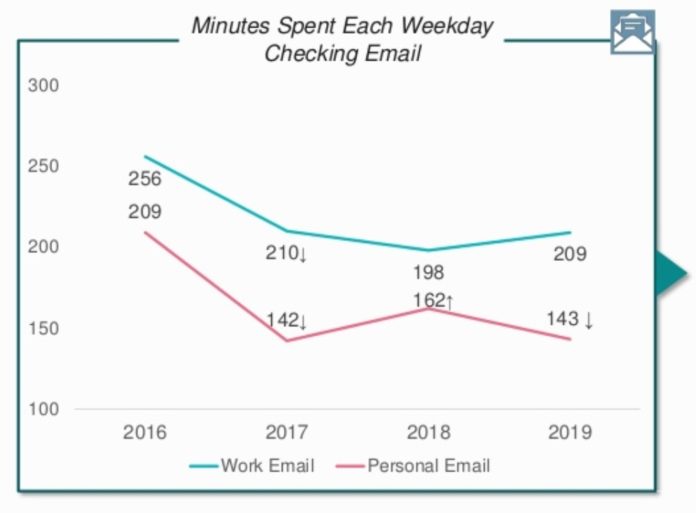Adobe’s 5th annual 2019 Email Usage Study, which surveyed 1,000 white collar workers in the U.S, found that consumers spend approximately five hours a day checking their emails, specifically three-plus hours a day on work email and two-plus hours a day personal email.
These consumers refresh their inboxes from a variety of times and places too: while watching TV, in bed, during work meetings, during meals, while driving – and even in the bathroom.
Emerging Trends
Despite most people checking work emails outside of the office, there is a growing trend to resist this urge, with almost half of consumers said they don’t check their work emails until they start working. Social media, which has seemingly taken over our lives, is mostly first checked when on a break at work (30%).
Baby Boomers are more likely to ignore work-related email while on vacation, but personal email is frequently checked. On the other hand, one-quarter of Millennials and Gen X check their work email multiple times a day when on vacation, while one-third do so with their personal email.
Commenting on the survey, Sarah Kennedy, Vice President of Global Marketing, Digital Experience at Adobe said “It’s incredibly clear that we’re all comfortable with email, and we’ve integrated it into almost every part of our day…The Adobe survey findings solidify how important email still is in the everyday lives of our customers, and this means there is still a big opportunity for marketers to utilize email to engage with people in relevant and useful ways. Contextual relevance and usefulness are critically important because you need both to deliver value to your customer and without them, you also risk being ignored.”
Emails Offers
Respondents also said they most prefer to receive offers this way (56% for work, 60% for personal), which is significantly more than direct mail, social, and other marketing channels.
However, only one-quarter of email offers from brands are interesting or compelling enough to open. Personalization in email marketing is important to consumers – especially in personal correspondence.
Broken down by generations, almost half of Millennials (46% ) said they want personalized email communications from brands, followed by 43% of Gen X and 30% of Baby Boomers. For work emails, 37% of Millennials want them personalized, as do 26% of Gen X and 23% of Boomers.
Consumers said they are most frustrated by email recommendations that don’t match up to their interests.
On the quintessence of personalized experiences, Sarah said, “Accurate and useful personalization in email marketing isn’t optional. It may sound simple, but get their names right. Provide offers for products and promotions they’ve already expressed interest in. Stop blasting mass emails to your entire subscriber list. Understand the implication of a customer’s job, location, historical behaviors, and anything else you know about them and have their consent to utilize.”
Inbox Zero – the goal of reaching no unread emails remaining at the end of the day, with all emails replied to, deleted, or otherwise accounted for – remains a distant dream for most. And fewer people are achieving it compared to 2018, but those who do, say it is a relief.
















